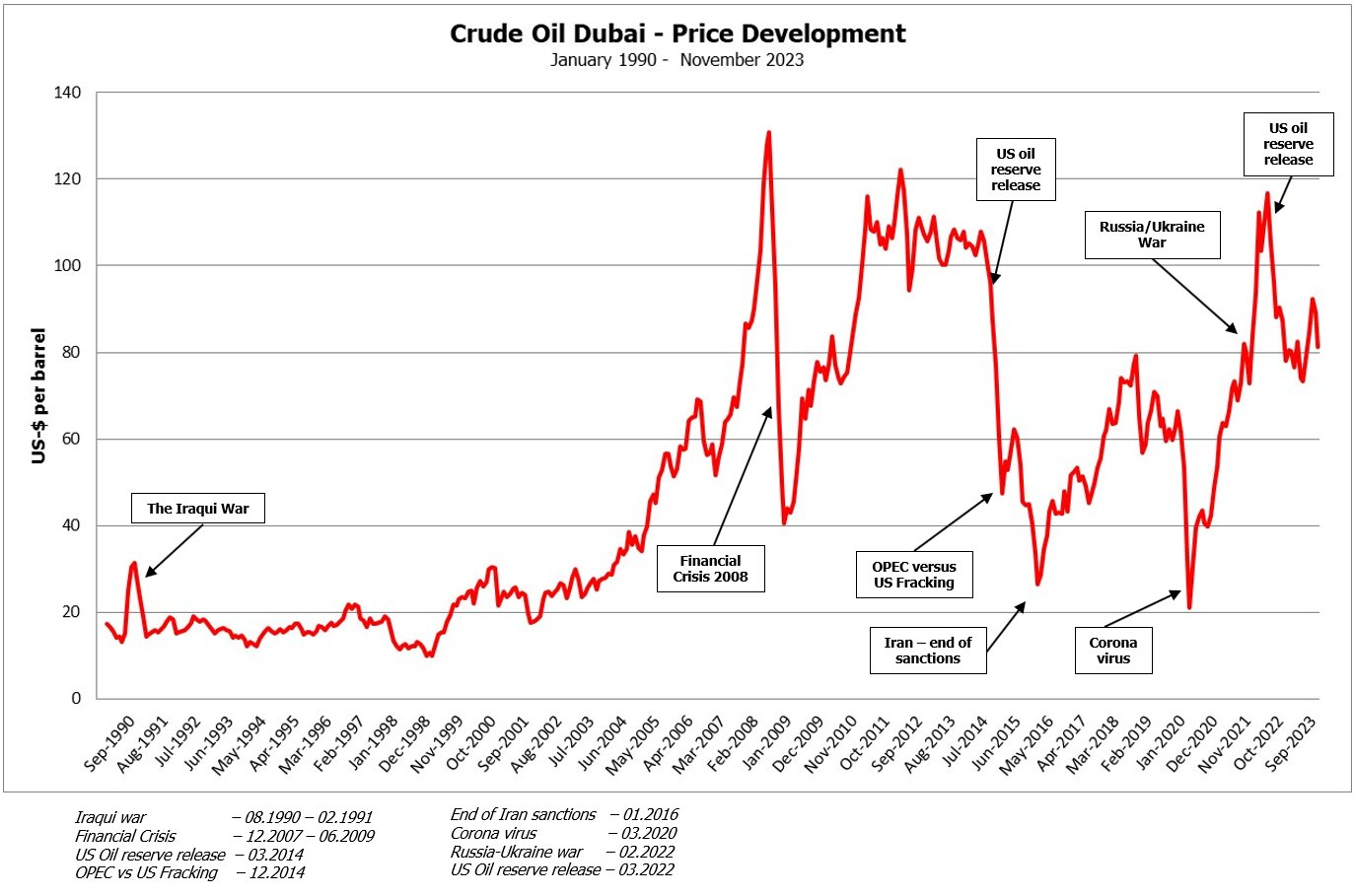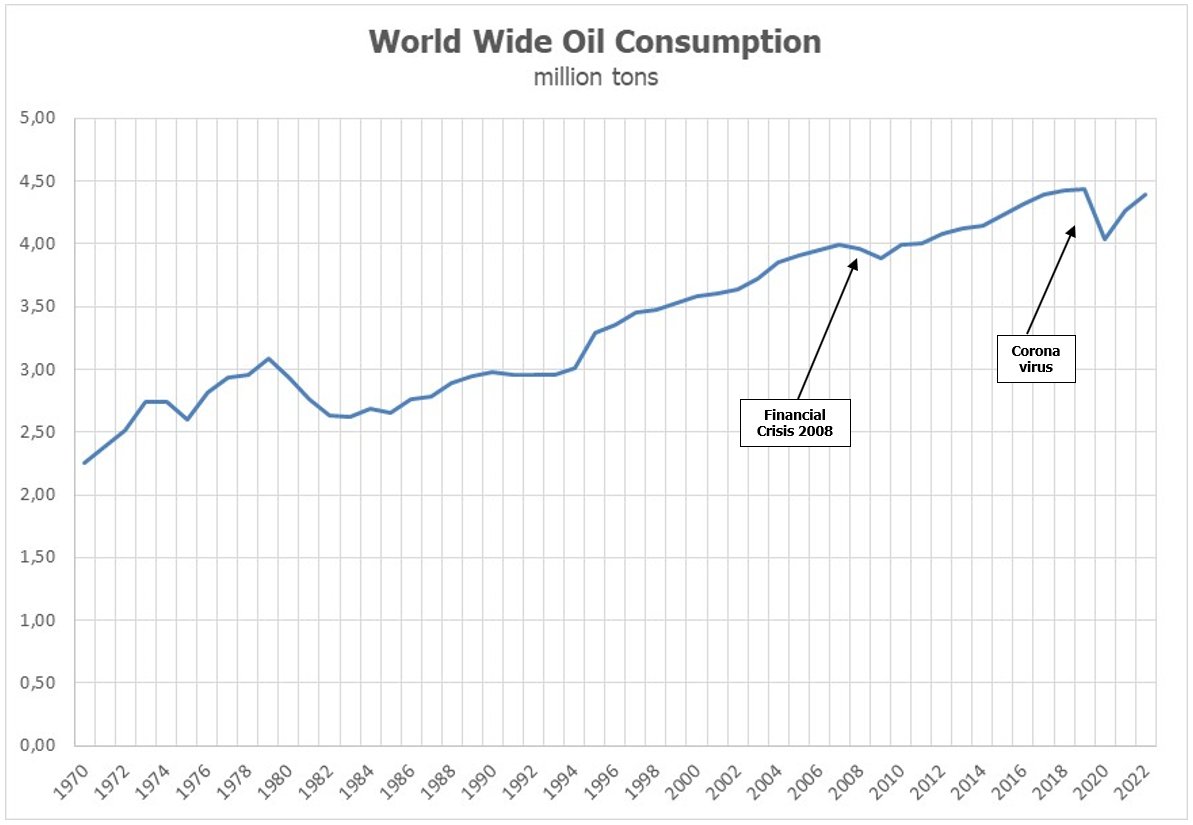All resources on earth are limited and major companies control energy, water and waste. The ongoing concentration in these markets is powered by guaranteed profit margins to be gained due to the dependence of countries, citizens and governments on these resources.
The oil price does not reflect the value of this finite resource but is used as a political instrument.
Published by Gerald Altnau in April 2008 / Updated: February 2024
In the EU plastic waste is primarily still regarded as substitute fuel and existing waste incineration over-capacities and their further expansion reduce available material for recyclers.
Without binding plastic recycling quotas there will be no progress in this industry and it will continue to follow the rules of the “Tragedy of the Commons”.
The Value of Oil
The price of oil continued to rise steadily until 2008 and raw-material cost for plastic production followed and led to consolidation and loss of work places. With the financial crisis 2008/2009 the oil price crashed and prices for commodity plastics and their raw materials decreased to an even greater extent. In the period from November 2008 until January 2009 benzene was even cheaper than oil (from which it is produced), showing how unrealistic the situation was.
At low oil prices investment in oil production is cut back, due to lower profitability, thus leading to a reduction of new projects, which will be taken up again when a recovering economy creates the pre-programmed supply crunch and pushes the oil price up again.
After the financial crisis has been overcome the price of oil rose again until mid 2011 and stagnated on this level until mid 2014, when the U.S. decided to sell part of their oil-reserve.
The price of oil halved within a year and the state finances of oil producing countries came under pressure. In return they carried on “flooding” the market with oil and Saudi Arabia especially targeted U.S. companies in the “fracking” industry. Beginning 2016 after the sanctions from the nuclear dispute came to an end Iran re-entered the market as important oil producer and the price of oil fell to the level of 2000.
 Then it went up again moderately until the coronavirus set everything back again in 2020. When things started to pick up again after a year, Russia invaded Ukraine and catapulted the oil price back above $110 per barrel. As an oil-producing country, this naturally suited Russia, as a war also has to be financed. In return, the USA threw part of its oil reserves onto the market and the price fell by around 20%.
Then it went up again moderately until the coronavirus set everything back again in 2020. When things started to pick up again after a year, Russia invaded Ukraine and catapulted the oil price back above $110 per barrel. As an oil-producing country, this naturally suited Russia, as a war also has to be financed. In return, the USA threw part of its oil reserves onto the market and the price fell by around 20%.
Over the last 20 years, the price of oil has been on a rollercoaster between $20 and $120 per barrel and the question is: "What effect has this had on consumption?".
Surprisingly, the oil price actually has no influence on consumption at all.
The dent from the “Financial Crisis” 2008 is almost invisible and only Corona can be clearly recognized, but the trend is unbroken.
It can only continue to go up, because humanity is growing, the standard of living is rising and military conflicts will certainly not be carried out with electric vehicles for the next 10 - 20 years, except for drones.
Despite the fact that every day the world discusses about finite resources and/or abandoning fossil energy as necessary steps in order to reduce the CO2 emissions, this necessity is not reflected in the oil price. In reality this price is rather an instrument for political and strategic objectives, which have little to do with the value of this finite resource.
Resource Dependency
Europe is the world’s biggest net importer of resources and the EU imported approx. 60% of the fossil fuels and metal resources in 2011 1). The new EU Action Plan for the Circular Economy 2) „Closing the Loop“ aims like all predecessor models at more recycling and reuse and the proposals include elements as:
- EU Recycling targets of 65% municipal waste and 75% packaging waste by 2030
- A ban on land-filling of separately collected waste
- Economic incentives for recovery and recycling (e.g. packaging, batteries, electro(nic) equipment, vehicles)
With such objectives the EU intends to reduce the consumption of resources, reduce waste and support recycling in order to reduce its resource dependency.
However it needs to be asked whether this scenario includes plastics at all.
The prices for plastics inevitably follow the price of oil and the cheaper it is the more expensive and less attractive becomes plastic recycling in the EU.
Mechanical Recyclers are a good example and are always victims when the low oil price makes new polymers cheaper than plastic recyclates and companies have to send their employees home.
If nobody (polymer producers, plastic article manufacturers and consumers) wants to pay for a Circular Economy, then it will not be implemented.
REACH and RoHS directives require new recycling technologies for the separation of dangerous pollutants, in order to enable recycling of such waste streams and prevent, that the majority will continue to be used as substitute fuel for waste incinerators.
But these are only proposed objectives and the final directive to be adopted at the end will only be the lowest common denominator, that the EU-27 (today without UK) will be willing to agree on and so we should not expect too many changes to the present status quo and until 2030 it is still a long way to go.
Basel and Stockholm Conventions
Since 1992 the Basel Convention 3) regulates trans-boundary movements of hazardous waste and the Stockholm Convention4) the handling of persistent organic pollutants since 2004.
Basel Convention
- Control of trans-boundary movements of hazardous waste and their disposal
- Implemented 5 Mai 1992
- Ratified by 181 UN member states, the Cook Islands, the EU and Palestine, but without the U.S. (exports 80% of its WEEE) – status July 2016
- EU: Regulation (EEC) No 259/93 of 1 February 1993, replaced by Regulation (EC) No 1013/2006 of 14 June 2006
Stockholm Convention
- Elimination or restriction of production and use of persistent organic pollutants (POPs)
- Implemented 17 May 2004 in Kraft
- Ratified by 152 states incl. EU, but without the U.S. - status June 2016
- EU: Regulation (EC) No 850/2004 of 24 April 2004
Consequently, it would be reasonable to assume that within the EU and when exporting the transport of dangerous waste is closely monitored and controlled. Persistent organic pollutants (POPs) are identified, listed and it is taken care of, that those no longer find use in new products and contaminated waste streams are demonstrably disposed of.
If it is still possible that only 1/3 WEEE shows up at the municipal collection points in the EU, another 1/3 is non-compliantly processed and the rest is exported or disappeared (CWIT Report 2015), then one must conclude that a realization and/or control of adopted regulations in member states is not possible or desired.
Plastic Recycling 2.0
As long as falling oil prices and the resulting falling prices for new polymers continue to shut down physical (mechanical) plastics recycling plants or drive them into insolvency, there will be no sustainable circular economy for plastics.
As long as polymer producers and manufacturers of plastic items are allowed to ignore the "external costs" (environmental pollution, health problems, impact on the food chain, etc.) of the waste from their products after use, as well as their costs for collection, sorting and recycling, no sustainable recycling industry will be able to establish itself and plastics will not be regarded as a valuable resource like metals, glass, paper, etc., for which we have high recycling rates.
Without a binding plastic recycling quota in the sense of REUSE, plastic waste will preferably be incinerated.
If the energy contained in the plastic is used in incomplete incineration to break down the polymers again into naphtha (oils and waxes, CO and water) or synthesis gas (H2, CO, CO2 and water) and referred to as chemical recycling, then a recycling quota may certainly be achieved. In any case, the energy stored in the plastic is lost again.
The recycling statistics will improve, but they only reflect an illusory reality.
Oil as a resource is simply too cheap.
It is a pity!
But that is just the way it is with the Tragedy of the Commons14).
Literature
- 2015.09.17 Julia Philipp „Chancen der Kreislaufwirtschaft“ zum Symposium 10 Jahre Elektroaltgeräte Koordinierungsstelle – Link
- Closing the Loop – An EU action plan for the Circular Economy - Link
- Basel Convention Wiki - Link
- Stockholm Convention Wiki - Link
- Kölnische Rundschau vom 08.07.2015 “Teure Müllverbrennung”. – Link
- Frankfurter Rundschau vom 13.03.2013 „Recycling – Verbrennen ist billiger“ – Link
- NABU „Mehr Müllimporte – weniger Recycling“ Homepage – last check 11.08.2016 – Link
- Marta Jofra Sora for Global Alliance for Incinerator Alternatives & GAIA: “Incinerator overcapacities and waste shipping in Europe – the end of the proximity principle?” Jan 7th, 2013: - Link
- GAIA “More incineration than trash to burn in the EU – last check of Homepage on 11.08.2016 – Link
- 2016/1 Communication from the EU Commission: Exploiting the potential of waste to energy under the energy union framework strategy and the circular energy – Link
- NTV “Giftcocktail in Flüssen und Meeren – Mikroplastik starker belastet als erwartet” vom 03.08.2016 – Homepage last check 11.08.2016 – Link
- Bundesinstitut für Risikobewertung BFR: Gesundheitliche Bewertung Nr. 041/2006 vom 1. Juni 2006: EU-Höchstgehalte für Dioxine und dioxinähnliche PCB in Fisch schützen …. nicht immer ausreichend“ – Link
- Umweltbundesamt „Dioxine und dioxinähnliche PCB in Umwelt und Nahrungsketten“ von 1.12.2013 – Link
- Tragedy of the Commons - Wiki - Link


